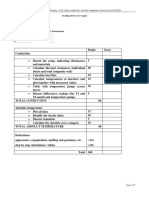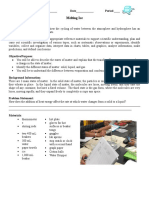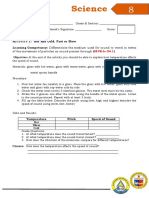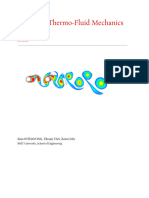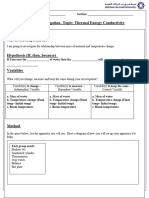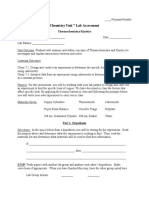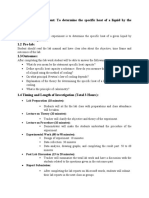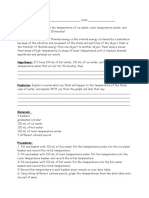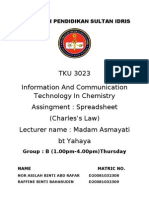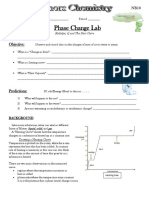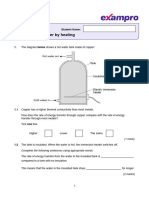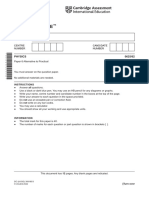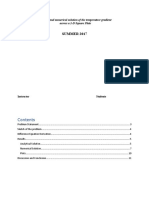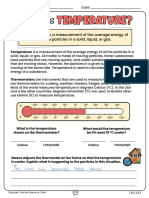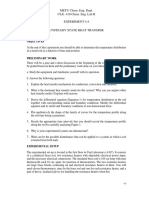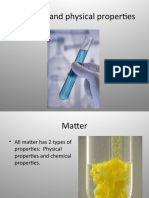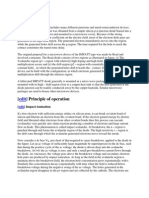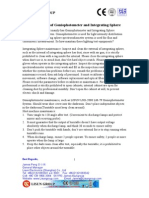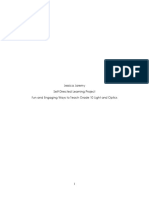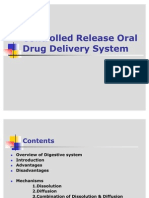Misp Thermal Conduction Worksheet #2 L2: Heat Conduction in Different Materials
Misp Thermal Conduction Worksheet #2 L2: Heat Conduction in Different Materials
Uploaded by
Aron MarielCopyright:
Available Formats
Misp Thermal Conduction Worksheet #2 L2: Heat Conduction in Different Materials
Misp Thermal Conduction Worksheet #2 L2: Heat Conduction in Different Materials
Uploaded by
Aron MarielOriginal Title
Copyright
Available Formats
Share this document
Did you find this document useful?
Is this content inappropriate?
Copyright:
Available Formats
Misp Thermal Conduction Worksheet #2 L2: Heat Conduction in Different Materials
Misp Thermal Conduction Worksheet #2 L2: Heat Conduction in Different Materials
Uploaded by
Aron MarielCopyright:
Available Formats
MiSP Thermal Conduction Worksheet #2 L2
Name _____________________________ Date _____________
HEAT CONDUCTION IN DIFFERENT MATERIALS
Introduction
Some materials are good conductors of heat. Some are poor conductors of heat. Those that are poor
conductors are called insulators.
Good heat conductors will absorb heat quickly and their temperature will increase quickly. Good
heat conductors will also release heat quickly and their temperature will drop fast.
Materials that are good conductors are used to allow heat to move from one place to another.
Insulators are used to prevent the movement of heat from one place to another.
Problems
Which materials are the best conductors of heat?
Which materials are insulators?
Hypotheses
1. If a material is a good heat conductor and is placed in hot water, then its temperature will
increase quickly/slowly (circle one).
2. If a material is a poor heat conductor (an insulator) and is placed in hot water, then its
temperature will increase quickly/slowly (circle one).
Materials:
goggles
3 materials: tubes/pipes/rods or strips made of aluminum, copper, plastic (PVC), glass, and/or
wood; your teacher will tell you which you will use. (Note: Each material sample will have a
stick-on thermometer attached at an equal distance from the bottom of the tube or strip.)
Hot water (approximately 50oC) — enough for one setup per group
Cool water (approximately 10oC) — enough for one setup per group
2 large beakers (or similar containers)
timer
MiSP Thermal Conduction Worksheet #2 L2 1
color pencils
Safety:
Wear goggles.
Use caution when handling the hot water.
Procedure: Check off each step as you complete it.
Fill one large beaker (or other container) with hot water (about 50oC) to a depth so that the
water level is approximately 4 cm below the thermometer. Fill the second large beaker (or other
container) with cool water (about 10oC) to the same depth. Set the cool water beaker aside.
Write on the data table the materials that your tubes or strips are made from.
Record the initial temperature of each tube or strip in the data table (time 0).
Place the three tubes or strips carefully in the beaker with hot water. Immediately start timing.
Record the temperature of each bar every 15 seconds (.25 minute) in the table for three minutes
or until one of the samples reaches the maximum temperature.
After 3 minutes or when one of the samples reaches the maximum temperature, move the tubes
or strips to the cool water beaker.
Note on your data table when the samples were moved to cool water.
Continue to record the temperature of each sample for another 3 minutes or until one of the
samples reaches the minimum temperature.
Convert the data in the seconds column to minutes by dividing by 60 seconds/minute.
MiSP Thermal Conduction Worksheet #2 L2 2
Record your data here:
Time Time Temperature Temperature Temperature
o o o
(seconds) Minutes C — Material: C — Material: C — Material:
Seconds (first __________ __________ __________
column)/
60 seconds per
minute
0 0
15 .25
Graph your data:
Graph the data on the next page to show the relationship between time (minutes) and the
temperature (oC) of each material.
Label the x–axis.
Label the y–axis. Key Color:
Connect the data points for each material. Use three different colors and write a key for the
_______________:
graph. _______________:
Title:_______________________ _______________:
MiSP Thermal Conduction Worksheet #2 L2 3
MiSP Thermal Conduction Worksheet #2 L2 4
Discussion:
1. Which material increased in temperature the quickest? the slowest? Which materials cooled the
fastest? the slowest? Complete the chart below:
Heating — Change Material Cooling — Change Material
in temperature in temperature
Fastest increase Fastest decrease
Medium Medium
Slowest increase Slowest decrease
2. Which material in your experiment is the best conductor? Explain. Refer to the graph in your
explanation.
___________________________________________________________________________
___________________________________________________________________________
3. Which material in your experiment is the worst conductor / the best insulator? Explain. Refer to
the graph in your explanation.
___________________________________________________________________________
___________________________________________________________________________
___________________________________________________________________________
4. If the materials were supplied with a constant (even) source of heat and were NOT moved to
the cool beaker, predict what the temperature would be in each material after 6 minutes (360
seconds).
Material: Predicted temperature after 6 minutes:
________________________ ________________________
________________________ ________________________
________________________ ________________________
5. Explain why the heat transfer in the experiment is conduction and not convection or radiation.
MiSP Thermal Conduction Worksheet #2 L2 5
___________________________________________________________________________
___________________________________________________________________________
___________________________________________________________________________
___________________________________________________________________________
___________________________________________________________________________
___________________________________________________________________________
MiSP Thermal Conduction Worksheet #2 L2 6
6. Look at the graph you made. Notice that as time passed, the temperature of each material
changed. You will compare the temperature changes when each material was in the hot water by
calculating the unit rate of change (slope) of each line. Use the information from the graph to
calculate the unit rates of change (slopes) for each material’s data on the graph. If your data all lie
on a line, determine the unit rates of change (slopes) of the lines. If your data points do not
produce lines, determine the unit rates of change (slopes) of best-fit lines. (If you use best-fit lines,
the ordered pairs to determine unit rates of change [slopes] must be from the best-fit line, not from your data
chart.)
Unit Rate of Change = Δ Temperature (oC) = ∆y = (y2 - y1)
Δ Time (minutes) ∆x (x2 - x1)
Material in Ordered Pair used Unit Rate of
Hot Water for calculation o Δ Time
Δ Temperature C Change
(x1, y1) (minutes)
Δy (slope)
(x2, y2) Δx
Δy/Δx
7. Are the calculated unit rates of change (slopes) positive/+ or negative/-? What does that tell you
about the changes in temperature as time passed?
___________________________________________________________________________
___________________________________________________________________________
___________________________________________________________________________
MiSP Thermal Conduction Worksheet #2 L2 7
8. In #2 you identified the best conductor and in #3 you identified the worst conductor (best
insulator). Compare those two materials’ unit rates of change (slopes). Discuss both the
numerical value and the sign (positive/+ or negative/-).
___________________________________________________________________________
___________________________________________________________________________
___________________________________________________________________________
MiSP Thermal Conduction Worksheet #2 L2 8
You might also like
- Problem Set 6 KeyDocument4 pagesProblem Set 6 KeyryezhuNo ratings yet
- MIME3450 Lab3 Conduction PDFDocument7 pagesMIME3450 Lab3 Conduction PDFshafahat0% (1)
- Chiro Shielding Guidelines Feb 14Document2 pagesChiro Shielding Guidelines Feb 14jopacameNo ratings yet
- Melting Ice LabDocument5 pagesMelting Ice LabCi'rayah LoweryNo ratings yet
- Activitygrade 8 Module 3Document6 pagesActivitygrade 8 Module 3annepauleentabangcurdaNo ratings yet
- Science 8 - Q1 - DW8Document3 pagesScience 8 - Q1 - DW8Argyll PaguibitanNo ratings yet
- Module 3 Activities G8Document9 pagesModule 3 Activities G8Julia Geonzon LabajoNo ratings yet
- Unit 2. Temperature and Heat EnergyDocument25 pagesUnit 2. Temperature and Heat EnergyDokta UrameNo ratings yet
- MIET1081 Computer Labs - Ver2019Document25 pagesMIET1081 Computer Labs - Ver2019Ahmad AlsadiNo ratings yet
- alkaseltzer_labDocument4 pagesalkaseltzer_lablarohaj579No ratings yet
- 03 Investigating Specific Heat SDocument13 pages03 Investigating Specific Heat Salex.taylor.1022No ratings yet
- Lab 3: Heat in The Earth: Z TZT T Erf TDocument3 pagesLab 3: Heat in The Earth: Z TZT T Erf TVipul ShrivastavaNo ratings yet
- Experiment 1 G-10Document5 pagesExperiment 1 G-10katlehomotaung021No ratings yet
- AC1 Thermal ConductivityDocument2 pagesAC1 Thermal ConductivityPhillip CookNo ratings yet
- 4.ChangeOfStateScientific InquiryDocument4 pages4.ChangeOfStateScientific Inquiryannasin8107No ratings yet
- Lectut CHN 201 PDF CHN 201 Manuals For Heat Transfer Lab - bcKmPL0Document44 pagesLectut CHN 201 PDF CHN 201 Manuals For Heat Transfer Lab - bcKmPL0pushkalNo ratings yet
- Week8 LS3 DLL Celsuis - FarenheitDocument9 pagesWeek8 LS3 DLL Celsuis - FarenheitJenielyn Sado100% (1)
- Science Investigation Planning Thermal Energy ConductivityDocument2 pagesScience Investigation Planning Thermal Energy ConductivityJason GarciaNo ratings yet
- Chemistry Unit 7 Lab Assessment: Thermochemistry/KineticsDocument6 pagesChemistry Unit 7 Lab Assessment: Thermochemistry/Kineticsapi-516602929No ratings yet
- 42 Heat TransferDocument6 pages42 Heat TransferChess ManNo ratings yet
- Thermalconductivity Measurement Experimen: Name of Student:-Sara Ghazi YahyaDocument4 pagesThermalconductivity Measurement Experimen: Name of Student:-Sara Ghazi Yahyasaaddssss23No ratings yet
- Heat Transfer Lab: Conduction: Experiment #1Document4 pagesHeat Transfer Lab: Conduction: Experiment #1api-529095602No ratings yet
- Lab Report-Thermal Equilibrium-Answerkey 2Document4 pagesLab Report-Thermal Equilibrium-Answerkey 2rawdhaalali940No ratings yet
- EXP#2 Conduction of Gases and LiquidsDocument6 pagesEXP#2 Conduction of Gases and LiquidsShahbazNo ratings yet
- Experiment-1 (Cooling Method)Document7 pagesExperiment-1 (Cooling Method)Redwanul HaqueNo ratings yet
- TH Lab 2Document12 pagesTH Lab 2AliNo ratings yet
- ME 200 Thermodynamics FinalDocument14 pagesME 200 Thermodynamics FinalElmaxNo ratings yet
- S3 Physics NotesDocument68 pagesS3 Physics Noteshk allegoNo ratings yet
- Thermal Equilibrium Lab 14-15-0Document3 pagesThermal Equilibrium Lab 14-15-0yeexinNo ratings yet
- Learning Packets G9 Q4 Physics Heat PumpsDocument2 pagesLearning Packets G9 Q4 Physics Heat Pumpsadelheidalcantara0414No ratings yet
- Charles LawDocument8 pagesCharles LawasilahrafarNo ratings yet
- ME 200 Thermodynamics 1 Fall 2017 - Exam 1Document8 pagesME 200 Thermodynamics 1 Fall 2017 - Exam 1ElmaxNo ratings yet
- SDocument37 pagesSDeniz AkkayaNo ratings yet
- Project 1.3.4 Renewable Insulation: Design ConstraintsDocument6 pagesProject 1.3.4 Renewable Insulation: Design ConstraintsSALTY RAMENNo ratings yet
- LAB 3 - Pre-Lab Keeping Heat Out PDFDocument5 pagesLAB 3 - Pre-Lab Keeping Heat Out PDFshaneearlNo ratings yet
- MECH3427-Assignment QuestionsDocument15 pagesMECH3427-Assignment QuestionsMandy ShiuNo ratings yet
- MEC701 Lab Manual W2016Document36 pagesMEC701 Lab Manual W2016Akash PatelNo ratings yet
- 10 Phase Change of Water - LAB 2020Document4 pages10 Phase Change of Water - LAB 2020Rohith GudatiNo ratings yet
- Heat Transfer Lab ManualDocument43 pagesHeat Transfer Lab ManualA SESHADRINo ratings yet
- Lab1 - Heat ConductionDocument6 pagesLab1 - Heat Conductionumromostafa7No ratings yet
- Lee's Disc Method: Thermal Conductivity: Aim of The ExperimentDocument6 pagesLee's Disc Method: Thermal Conductivity: Aim of The ExperimentAryan VermaNo ratings yet
- MEC701 Lab Manual W2015Document36 pagesMEC701 Lab Manual W2015Isra SajjadNo ratings yet
- 7 Thermochemistry The Heat of ReactionDocument9 pages7 Thermochemistry The Heat of ReactionV GozeNo ratings yet
- Sam Green - P2 Test (RAB 2021) - QP (37 Marks Tot)Document6 pagesSam Green - P2 Test (RAB 2021) - QP (37 Marks Tot)samkgreNo ratings yet
- G9 Revision NotesDocument74 pagesG9 Revision Noteskwokrenee827No ratings yet
- ME305 EndSemKEY 02122016Document5 pagesME305 EndSemKEY 02122016sameerakhatoon05No ratings yet
- Cambridge IGCSE: PHYSICS 0625/62Document12 pagesCambridge IGCSE: PHYSICS 0625/62taha imranNo ratings yet
- HMT Lab Report: AssignmentDocument27 pagesHMT Lab Report: AssignmentM Junaid tabassumNo ratings yet
- Arts PracticalDocument42 pagesArts PracticalbuccopycenterNo ratings yet
- ASEN 3113 Fall 2013 Lab 2Document5 pagesASEN 3113 Fall 2013 Lab 2Fro PlumeNo ratings yet
- ENTHALPY CHNAGES_W22_34Document3 pagesENTHALPY CHNAGES_W22_34Sonal SinglaNo ratings yet
- 02 Heat of Fusion VaporizationDocument14 pages02 Heat of Fusion Vaporizationvikas4uallNo ratings yet
- Heat Exchanger Lab Report - Reference MaterialDocument30 pagesHeat Exchanger Lab Report - Reference MaterialFarwa RizviNo ratings yet
- Final ReportDocument27 pagesFinal ReportNevil PatelNo ratings yet
- Final Project Report - Group 4Document11 pagesFinal Project Report - Group 4Sravan DandaNo ratings yet
- Avin Maroozi - Lesson 5Document4 pagesAvin Maroozi - Lesson 5Avin MarooziNo ratings yet
- Lab E: Colourful Convection CurrentDocument4 pagesLab E: Colourful Convection CurrentRustini HandaNo ratings yet
- METU Chem. Eng. Dept. Ch.E. 410 Chem. Eng. Lab II Experiment 4.4 Unsteady State Heat TransferDocument5 pagesMETU Chem. Eng. Dept. Ch.E. 410 Chem. Eng. Lab II Experiment 4.4 Unsteady State Heat TransferGautham Raavo PainaiduNo ratings yet
- Thermal Design: Heat Sinks, Thermoelectrics, Heat Pipes, Compact Heat Exchangers, and Solar CellsFrom EverandThermal Design: Heat Sinks, Thermoelectrics, Heat Pipes, Compact Heat Exchangers, and Solar CellsRating: 5 out of 5 stars5/5 (1)
- 247 1Document6 pages247 1Aron MarielNo ratings yet
- Consolidated Division School Forms Checking ReportDocument2 pagesConsolidated Division School Forms Checking ReportAron MarielNo ratings yet
- WeatheringDocument18 pagesWeatheringAron MarielNo ratings yet
- Soil Erosion: Leached of ...Document2 pagesSoil Erosion: Leached of ...Aron MarielNo ratings yet
- A Roman Catholic View of Population ControlDocument25 pagesA Roman Catholic View of Population ControlAron MarielNo ratings yet
- Insulators & Conductors WORD ScrambleDocument18 pagesInsulators & Conductors WORD ScrambleAron MarielNo ratings yet
- Force, Motion, and Energy: NameDocument1 pageForce, Motion, and Energy: NameAron MarielNo ratings yet
- Insulators and Conductors: Provided by TryengineeringDocument10 pagesInsulators and Conductors: Provided by TryengineeringAron MarielNo ratings yet
- Nutrition Word Scramble: Unscramble The Letters To Solve The Puzzle!Document2 pagesNutrition Word Scramble: Unscramble The Letters To Solve The Puzzle!Aron MarielNo ratings yet
- Chemical and Physical PropertiesDocument21 pagesChemical and Physical PropertiesAron MarielNo ratings yet
- Parents ConsentDocument1 pageParents ConsentAron MarielNo ratings yet
- Apparent Viscosity of Foam in Homogeneous Bead PackDocument10 pagesApparent Viscosity of Foam in Homogeneous Bead PackHerru As SyukriNo ratings yet
- Product Specifications: VHLP1 15 1WHDocument4 pagesProduct Specifications: VHLP1 15 1WHmdisicNo ratings yet
- Lab Report 1Document2 pagesLab Report 1api-249188694No ratings yet
- Basics of Foundation Design PDFDocument433 pagesBasics of Foundation Design PDFGnkdsNo ratings yet
- Stress Analysis For The Start Up OpDocument10 pagesStress Analysis For The Start Up OpEnimizufa DiepreyeNo ratings yet
- Timetal 834 Timet Data SheetDocument2 pagesTimetal 834 Timet Data SheetBonnie AttardNo ratings yet
- A Micro-Computer Program For The Elastic-Plastic Analysis and Optimum Design of Plane FramesDocument7 pagesA Micro-Computer Program For The Elastic-Plastic Analysis and Optimum Design of Plane Framesjuan carlos molano toroNo ratings yet
- Cosmological ConstantDocument23 pagesCosmological Constantsipobey750No ratings yet
- Impact DiodeDocument3 pagesImpact DiodeJalpesh LadNo ratings yet
- UPVC Technical Data SheetDocument1 pageUPVC Technical Data SheetRND KencanaNo ratings yet
- Maintenance of Goniophotometer and Integrating SphereDocument3 pagesMaintenance of Goniophotometer and Integrating SphereLisun GroupNo ratings yet
- Mcfarland Standards: PRODUCT CODE SD2350, SD2300, SD2301, SD2302, SD2303, SD2304Document1 pageMcfarland Standards: PRODUCT CODE SD2350, SD2300, SD2301, SD2302, SD2303, SD2304SOKAMTE TEGANG AlphonseNo ratings yet
- Sublimation and Melting Point of Impure Benzoic AcidDocument3 pagesSublimation and Melting Point of Impure Benzoic AcidPau VanaderoNo ratings yet
- Jessica Jaremy Self Directed Learning Light and OpticsDocument39 pagesJessica Jaremy Self Directed Learning Light and Opticsapi-394957459No ratings yet
- Modsim: Modular Simulator For Mineral Processing PlantsDocument3 pagesModsim: Modular Simulator For Mineral Processing PlantsRaulNo ratings yet
- AISI RP19-3 Direct Strength Prediction of Purlins With Paired Torsion Bracing 2019-10Document42 pagesAISI RP19-3 Direct Strength Prediction of Purlins With Paired Torsion Bracing 2019-10Todd HenryNo ratings yet
- 123 Final Set ADocument1 page123 Final Set Apauly_simanjuntakNo ratings yet
- light commercial compressor技术交流资料20170702Document29 pageslight commercial compressor技术交流资料20170702Ali MoazzamNo ratings yet
- OE ReviewDocument3 pagesOE ReviewRalph Mattew Palomaria100% (1)
- Michael M. Calistrat: Safety, Application, and Service Factors As Applied To Shaft Couplings byDocument8 pagesMichael M. Calistrat: Safety, Application, and Service Factors As Applied To Shaft Couplings byronny_fernandes363No ratings yet
- GreenHouse EffectDocument4 pagesGreenHouse EffectOliviaNo ratings yet
- Table 1-Typical Rubber Properties Used in The Oil WellDocument8 pagesTable 1-Typical Rubber Properties Used in The Oil WellabodolkuhaaNo ratings yet
- Stress Analysis On Piping SystemsDocument42 pagesStress Analysis On Piping SystemsMalar50% (2)
- Metrode 410NiMo B-11Document4 pagesMetrode 410NiMo B-11Claudia MmsNo ratings yet
- Materiales Aislantes e ImpermeabilizantesDocument8 pagesMateriales Aislantes e ImpermeabilizantesEsau AguillónNo ratings yet
- Vehicle Dynamics and Modelling: Tractive EffortDocument8 pagesVehicle Dynamics and Modelling: Tractive EffortKrishi ShahNo ratings yet
- Preboard-23-24 SET A-QPDocument8 pagesPreboard-23-24 SET A-QPChoco CookieNo ratings yet
- Controlled Release Oral Drug Delivery Systems 9Document46 pagesControlled Release Oral Drug Delivery Systems 9Rahul Nair50% (2)

